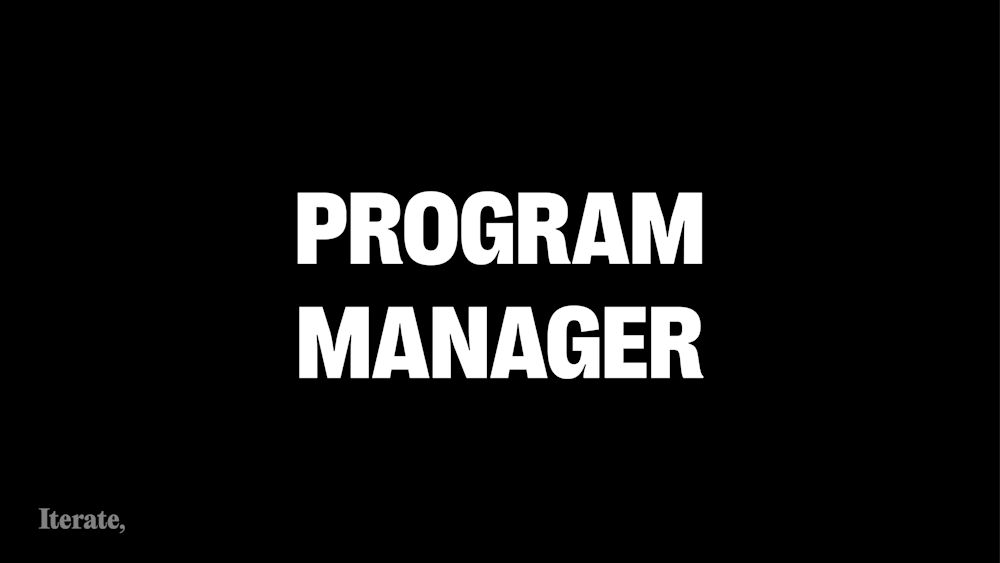Table of contents
Discover the role of program managers and learn what their daily tasks look like, what the job requirements typically are, and how to hire the best in the field.

What is a Program Manager?
A program manager is a professional who oversees the planning, execution, and coordination of multiple projects within an organization to achieve strategic objectives. They provide leadership and direction to project teams, ensure that projects are completed on time and within budget, and manage resources, risks, and stakeholders. Program managers also establish and maintain communication channels among project teams, senior management, and other stakeholders, and they are responsible for monitoring progress and much more. The role of a program manager is crucial in aligning projects with organizational goals and ensuring successful program delivery.
Recruiting the best system administrator requires a thorough evaluation of technical skills, business acumen, communication, collaboration, and alignment with the organization's goals. Only then can your IT department function seamlessly.
If you are looking for a job as a program manager, you can check out the open positions below.
How Much Does a Program Manager Make?
The average salary of a program manager varies depending on factors such as location and industry. In the United States, according to data from the U.S. Bureau of Labor Statistics and Industry surveys, as of 2021, the average annual salary for program managers ranged from $94,500 to over $150,000, with a median salary of around $116,000. However, salaries can be higher for program managers with extensive experience, specialized skills, or in-demand expertise. In terms of program managers making the highest annual salaries, the answer lies in the technology and software industries.
- Qualcomm - $169,076
- Northrop Grumman - $165,192
- Jacobs - $152,253
What are the Job Responsibilities of a Program Manager?
Naturally, the job responsibilities of a program manager vary by industry and organization. However, the most common job responsibilities are as follows.
- Planning and program development.
- Overseeing project portfolios and managing budgets and resources.
- Leading and motivating project teams and establishing project goals and objectives.
- Coordinating and aligning projects with organizational objectives, monitoring progress and performance, and identifying and mitigating risks.
- Communicating with stakeholders, reporting on program status, and ensuring timely and successful delivery of program outcomes.
- Providing leadership and direction to project teams, resolving issues and conflicts, and making strategic decisions to ensure the successful execution of programs.
- Collaborating with stakeholders at all levels of the organization, including senior management, cross-functional teams, clients, and external partners, to achieve program objectives and drive business results.
Meeting a Program Manager
It’s one thing to know the requirements of a role — it’s another to see yourself in it. At The Org, we believe that putting faces to the job title can provide more context and a better sense of how the role fits into the big picture.
Explore live positions for program managers and meet the people behind the title here.
Tips for Recruiting Your Dream Program Manager
At first, recruiting a talented program manager might seem challenging, but we encourage you not to stress. Instead, employ the tips found below and you’ll find yourself enjoying a smooth, effective process that leads you to a pool of potential.
- **Define what “good” looks like. **Before beginning the recruiting process, we recommend sitting down and figuring out exactly what good means to you. Because in the end, the project manager that works best for you won’t necessarily be the same one that works for you.
- **Score by CV. **Now that you have an understanding of what you’re looking for, it’s a good idea to evaluate each candidate's CV, keeping desired characteristics in mind. For instance, if you want someone with good communication skills, you’ll want to rule out anyone whose CV has grammatical errors.
- **Don’t require someone that just finished a similar project. **Too many people make the mistake of prioritizing a person’s domain and technical skills. Instead, focus on a person’s behavioral skills to ensure they’ll be a good fit for your company.
- **Define your company’s culture. **Taking finding a candidate that fits in with your existing culture one step further, make sure you include relevant info in your description to draw in the right applicants.
At The Org, we believe traditional recruiting is in need of a refresh. Candidates want to know who they’ll work with, not just what they’ll do. Workplace culture, interpersonal relationships, and company values are more important now than ever.
And what better way to showcase your company’s unique culture than through your Org Chart?
Highlight different teams in your organization, the people that make these teams great, and show candidates how they fit into the big picture.
Your Org Chart is a novel and effective way to show candidates where they fit in, and to show off your greatest asset: your people.
Explore Org Charts here, and sign up today to create your own customized Org Chart for your company.


The ORG helps
you hire great
candidates
Free to use – try today